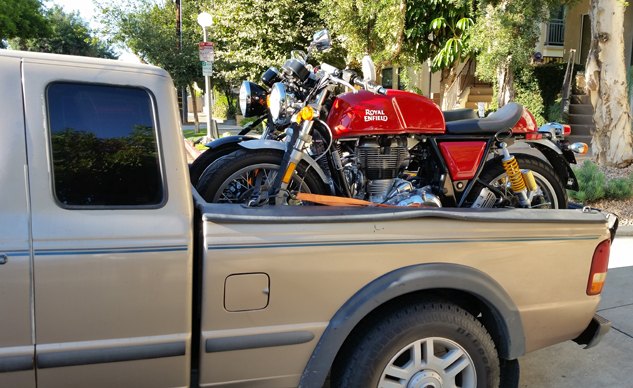Trizzle's Take – The Art Of Loading

We've all got our ways.
Many years ago, when I was working at another magazine, the company had a big box van we could use to haul tools, equipment, and most importantly, motorcycles. It was a Ford F450 if I remember correctly, with a V-10 engine and its fair share of miles. The driver’s seat had seen better days by this point, and I think the rear diff was starting to leak a little fluid, too. The “attic” portion of the box was where we kept tools, fluids and miscellaneous pieces, and the main cargo area was set up to fit three motorcycles. Straps were neatly arranged at each station, and when it came time to secure my first motorcycle, I discovered a strange phenomena: there are several ways to strap down a bike, and your way is wrong.
At least that was the message I got from our shop foreman and primary driver of the truck, Michael (last name withheld to protect the guilty). A knowledgeable bloke, and very organized fellow, Michael was very particular about “his” truck (it didn’t belong to him, but he racked up the most miles in it) and how bikes were loaded. Mounting points varied depending on the kind of bike being transported and the strap being used differed, too. Even the technique changed depending on the kind of bike it was. Soft tie or Canyon Dancer? Ratchets or cam buckle? Michael had an opinion, and he was sure to let you know it.
Throughout the years, though, I’ve noticed Michael wasn’t the only one particular about keeping bikes secured to their trucks. Go to any trackday or motocross track and you’ll find plenty of people willing to take your help pushing a bike onto the back of their pickup, followed by, “Thanks, I can get it from here.” Your help is no longer needed because what follows is an intricate and complicated procedure and frankly, nobody has time to teach it to you.
I’ll admit, I’m guilty of this phenomena myself. Here at MO we don’t have hired help to retrieve motorcycles for us while we’re typing away on our next masterful shootout. You know who picks up bikes? We do. Four of the five of us have pickup trucks, and those are split between nearly-drinking-age Ford Rangers (myself and Burns) and shiny late-model Toyota Tacomas (Evans and Tom). Sure I’d like a new truck, but my trusty Ranger was paid off long ago and starts up every single time. It’s hard to argue with that.
Despite my desires for a new truck, there’s a certain familiarity I’ve built with my Ranger. By now I can nearly load a bike into my Ranger with my eyes closed. I’ve got a set routine I follow if I’m loading one bike, and a slightly different one for two. And yes, I did pick up a few things from Michael. My gear is minimal, and while I much prefer the convenience of cam buckles, I bust out the ratchets for certain situations. And while each bike will have their own specific set of challenges when finding tie-down points, one thing remains the same: after the bike is pushed up the ramp and into my truck, I’ll figure out the rest.
After a recent trackday, I needed to bring two bikes back with me. So, after getting help pushing the two bikes into my truck, one fellow, I’m sure out of the goodness of his heart, started fumbling with straps – my straps – in an attempt to help speed up the process. Kindly, but deliberately, an “I got this” followed. The help was appreciated, but really, the process is faster alone. Harsh, maybe, but I’ve also been on the other side of an “I got this” once or twice before.
We’ve all got our routine, and as long as it works to get the job done, who are we to judge? Some like to use every strap available to them to secure their bike like Fort Knox. Others prefer to angle the front tire in the corner, allowing the rear to swing to the side and the gate to close. There really isn’t a wrong answer, as long as the bike doesn’t fall down. All I know is, if I’m not specifically asked, I’m not messin’ with another man’s (or woman’s) straps.

Troy's been riding motorcycles and writing about them since 2006, getting his start at Rider Magazine. From there, he moved to Sport Rider Magazine before finally landing at Motorcycle.com in 2011. A lifelong gearhead who didn't fully immerse himself in motorcycles until his teenage years, Troy's interests have always been in technology, performance, and going fast. Naturally, racing was the perfect avenue to combine all three. Troy has been racing nearly as long as he's been riding and has competed at the AMA national level. He's also won multiple club races throughout the country, culminating in a Utah Sport Bike Association championship in 2011. He has been invited as a guest instructor for the Yamaha Champions Riding School, and when he's not out riding, he's either wrenching on bikes or watching MotoGP.
More by Troy Siahaan































Comments
Join the conversation
While I try to not carry my bikes in my truck, I do have a truck, so I have to rescue other folks occasionally. I strongly prefer ratchet straps with some looped attachment points. Each to his own.
I was hoping to hear how you actually load the bikes into the trucks. What types of ramps? single, double? push them in? ride them in? Back the truck up to an incline to minimize the height difference? I'm sure there are many ways to secure /strap them but the most challenging part still seems to be getting them from the ground into the bed without creating a youtube moment where the bike and possibly the loader fall
back on the ground. Ouch!